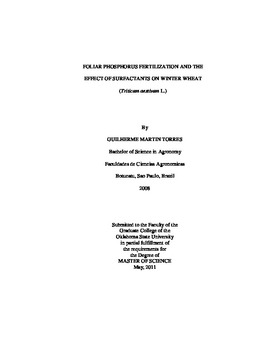| dc.contributor.author | Torres, Guilherme Martin | |
| dc.date.accessioned | 2014-04-15T22:06:25Z | |
| dc.date.available | 2014-04-15T22:06:25Z | |
| dc.date.issued | 2011-05-01 | |
| dc.identifier.uri | https://hdl.handle.net/11244/9374 | |
| dc.description.abstract | Reactions of phosphorus fertilizer in soils make its use efficiency very low. The common application practices are to broadcast and incorporate or to band P with the seed. Foliar application of P can be used as a supplemental P source allowing for the application of lower rates and when it is most needed, reducing costs and potential environment concerns due to surface run-off. The objective of this study was to evaluate the effect of applying triple super phosphate as a foliar P source with and without surfactant on winter wheat grain yield, phosphorus use efficiency, and grain P content. Four field trials at two experimental sites were established in 2008/2009 and 2009/2010 in Oklahoma using a randomized complete block design with three replications. Treatments were applied at Feekes 7 using triple super phosphate dissolved in water as a foliar fertilizer. The solution had a concentration of 66 g P L-1. All treatments received 112 kg N ha-1 preplant in both trials. The effect of broadcast preplant at rates of 0, 10, 20, and 40 kg P ha-1 and foliar top-dress at rates of 0, 5, and 10 kg P ha-1 were evaluated, with and without surfactants. Foliar P fertilization and the combination of preplant and foliar P often resulted in a yield increase compared to the check and/or the broadcast application of 20 and 40 kg P ha-1. These methods of fertilization frequently produced maximum yield. Phosphorus use efficiency was improved with foliar nutrition compared to broadcast. The effect of foliar P on grain P concentration was not consistent. The influence of surfactant was also not consistent over trials. Non-ionic surfactant and crop oil improved phosphorus use efficiency, grain yield and grain P concentration compared to the lack of a surfactant in some cases but had a negative impact in other occasions. Foliar fertilization using TSP at 10 kg P ha-1 had a negative impact on yield and grain P concentration. Foliar P allows for supplemental applications of phosphorus and when it is most needed. Foliar P allows for the application of lower rates in relation to soil applied P while still being able to correct in-season deficiencies, and improve yield and phosphorus use efficiency. | |
| dc.format | application/pdf | |
| dc.language | en_US | |
| dc.publisher | Oklahoma State University | |
| dc.rights | Copyright is held by the author who has granted the Oklahoma State University Library the non-exclusive right to share this material in its institutional repository. Contact Digital Library Services at lib-dls@okstate.edu or 405-744-9161 for the permission policy on the use, reproduction or distribution of this material. | |
| dc.title | Foliar Phosphorus Fertilization and the Effect of Surfactants on Winter Wheat (Triticum aestivum L.) | |
| dc.type | text | |
| osu.filename | Torres_okstate_0664M_11355.pdf | |
| osu.college | Agricultural Sciences and Natural Resources | |
| osu.accesstype | Open Access | |
| dc.description.department | Department of Plant and Soil Sciences | |
| dc.type.genre | Thesis | |
| dc.subject.keywords | foliar phosphorus fertilization | |
| dc.subject.keywords | in-season phosphorus application | |
| dc.subject.keywords | phosphorus use efficiency | |
| dc.subject.keywords | wheat | |
